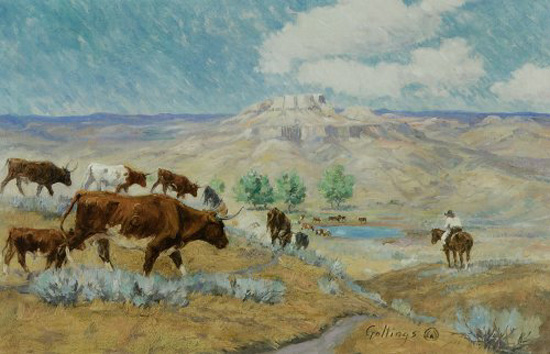
"Three Circle Cattle," Bill Gollings. For more Gollins paintings see
Gollings
The Three Circle, about 45 miles north of Sheridan, is located along the Upper Tongue and Rosebud near Birney, Montana.
Neither Birney or the Three circle are in Wyoming, but instead are a short distance from the state line and somethimes are
associated with Sheridan. Indeed, the writer received an email from an indiviudal who had an old friend from
"Birney, Wyoming" The correspondent had searched in vain for Birney but was unable to find it. The history of Birney, the Three
Circle and the Quarter Circle U is nevertheless included here in that it provides insight
in a microchosm of the changes in the stock industry on the northern Great Plains following World War I, the financial
difficulties of the 1920's, supplementing income by herding dudes, the expansion of the
mineral industry leading to the possible destruction of the stock industry and recent battles over water rights.
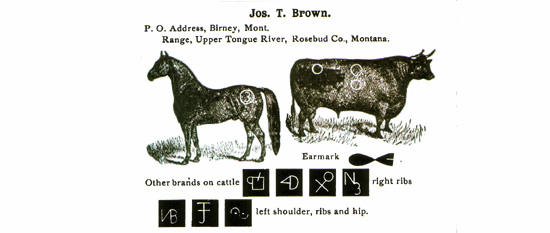
Three Circle Brands, 1903
The Three Circle and the Quarter Circle U, in contrast to some of the resort type of Dude Ranches near Jackson, Wyoming, were primarily stock ranches which
supplemented income by taking in "dudes.
The Three Circle was established in the mid-1880's by Captain Joe Brown (Joseph Taliaferro Brown, 1849-1908). Birney, named after Arthur M. Birney, is now
practically a ghost town. The Three Circle home ranch was located a little north of Birney. Captain Brown, was born in
Mississippi and at age 14 participated in the Confederate response to Benjamin Grierson's raid from
Tennesee through Mississippi as a diversion to Grant's Vicksburg Campaign. He was captured by
Union Soldiers but was let go, possibly in part due to his age. At age 15, he again listed in Regular
Confederate Forces and served under Nathan Bedford Forrest. Following the Civil War he entered
the Kentucky Military Institute followed by the University of Virginia where he received a law degree.
Captain Joe Brown was employed by the Missouri Pacific Railroad both as an attorney and civil engineer until he settled on the
Tongue River. He later served in the Montana Legislature, served in a Montana Unit during the
Spanish-American War, served as President of the Montana Cattlemen's Association, and as a Democratic presidential elector. Just as life on the range the early years of the
past century was depicted by
Bill Gollings and on the
Pitchfork
Charles J. Belden, the Three Circle and the Quarter Circle U was
featured in a series of photographs taken by Farm Security Administration photographers
Arthur Rothstein in 1939 and Marion Post Wolcott in 1941.
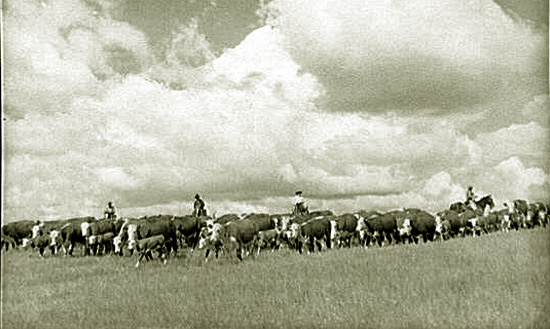
Three Circle Cattle, Arthur Rothstein.
Rothstein accompanied the Three Circle Cowboys on their annual roundup into the Custer National Forest. Having been born in
Manhattan, gone to school and college in New York, it was a new experience. He had never ridden a horse
before. As he rode the range with "real cowboys" and ate at the same table, his photos changed no longer depicting the
bleakness, gloominess, misery and proverty of the depression that the New Deal and Dr. Tugwell sought to alieviate.
His photos from the Three Circle have sunny skies. Indeed one photo of a Three Circle roundup was criticized by a fellow
Farm Security Administration photographer as a "silly sentimental picture."
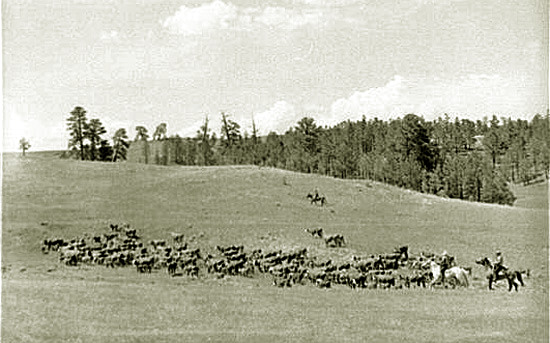
Three Circle Roundup, Arthur Rothstein.
In 1905, the Custer National Forest as established. This opened up 1.3 million acres for rangeland. Indeed,
until 1960, the Brown Cattle Co. and the
Quarter Circle U continued to maintain large leases. A large grazing area was required. It is generally accepted that
35 acres of grazing land is required to support one cow. To provide an income, a herd of at least
100 head is required. In other words, a homestead of 160 acres is insufficient to support a family.
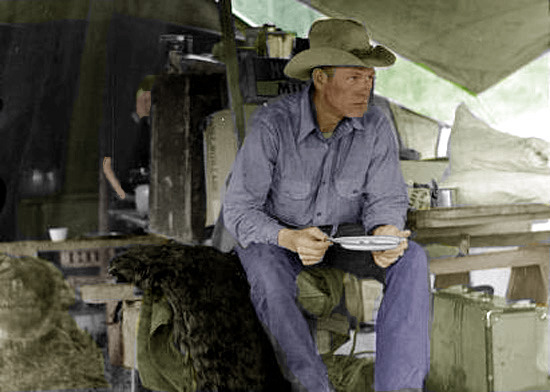
Three Circle Roundup Camp Mess, Photo by Arthur Rothstein, color
by Geoff Dobson.
As indicated in the above photograph, in his photography, Rothstein was instructed by Roy Stryker to include the small items which depict poverty. Rothstein recalled,
"Roy was the one who made me aware of the fact that there is a great deal of
significance in small details. He made me aware of the fact that it was important,
say, to photograph the corner of a cabin showing an old shoe and a bag of flour; or it
was important to get a close-up of a man's face; and it was important to show a window
stuffed with rags.Oral history interview with Arthur Rothstein, 1964 May 25, Archives of American Art, Smithsonian Institution.
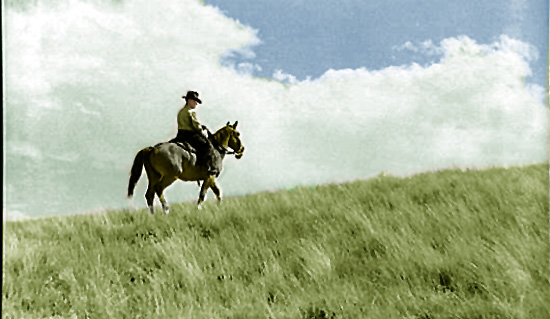
Three Circle Rancher, Photo by Arthur Rothstein, color
by Geoff Dobson.
In obtaining photographs, Rothstein developed an approach he called the
"unobtrusive camera." In the oral history interview, he explained:
Now the first assignment, if I remember correctly, was in the Blue Ridge Mountains of
Virginia. We had a group of people there that were being moved out to make way for a
national park, Shenandoah national Park, and these people were all people who lived
in the hills and the hollows of the Blue Ridge Mountains not far from Washington,
about eighty miles from Washington. I went out there and was in a cabin on the top of a
mountain for a few weeks, walked around and became acquainted with these people. At the
beginning they were very shy about having pictures taken, but I would carry my camera along
and make no attempt to take pictures. They just got to know me, and finally, they didn't mind
if I took a few pictures. I took quite a few unusual pictures at that time using a Leica camera
and a technique that is almost a standard. A technique that I developed out of necessity all
by myself which I call the "unobtrusive camera," the idea of becoming a part of the environment
that the people are in to such an extent that they're not even aware that pictures are being
taken.


Left: Three Circle, Branding a Calf, Right: Saddling Up
Photos by Arthur Rothstein, Color by Geoff Dobson


Left: Quarter Circle Cowboy Eating Rocky Mountain Oyster,
Right: Quarter Circle Branding Irong
Photos by Arthur Rothstein, Color by Geoff Dobson
Following Captain Joe Brown's death in 1908, operation of the Three Circle was taken over by his son,
Albert Gallatin Brown II. Brown incorporated the Brown Cattle Co. in 1918. In the 1930's both the Three Circle and the Quarter Circle
U hosted dudes as a means of supplementing income. A portion of the Cecil B. DeMille movie, "The Plainsman," starring Gary Cooper, was shot on the Quarter Circle
U.

Three Circle Cowhand, Photo by Arthur Rothstein, color by Geoff Dobson
In 1947, the Quarter circle U became part of the X Bar Diamond Cattle Co. The Brown Cattle Co. continues to own the
Three Circle.
Music this page: I Ride an Old Paint
Next Page, Three Circle continued, Birney, Montana.
|